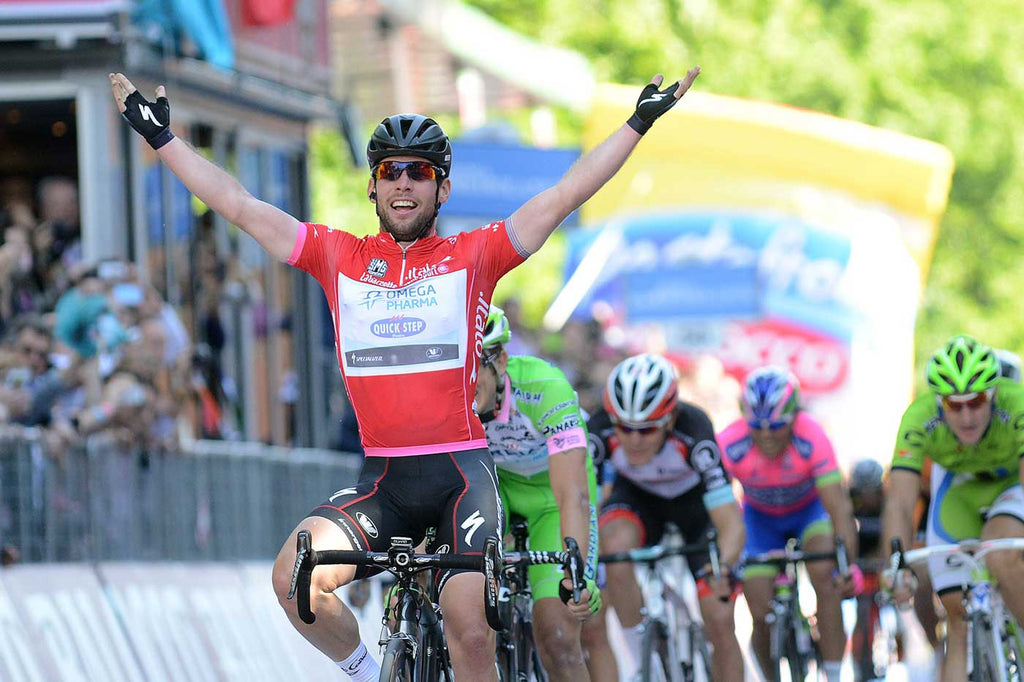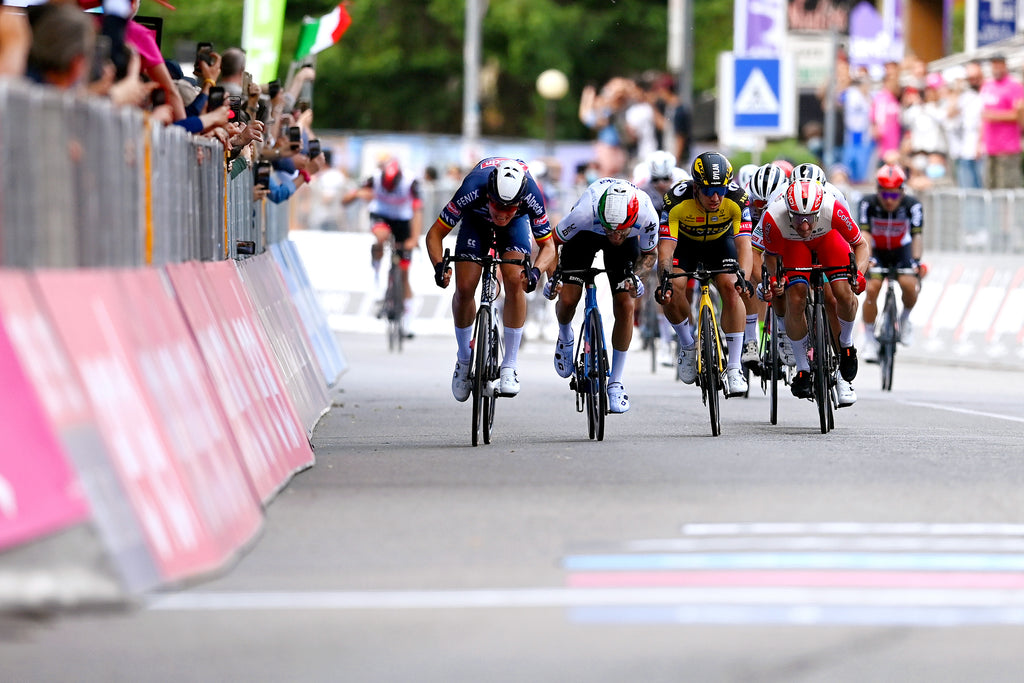With the mountainous terrain typically covered in Italy, the Giro hasn’t always been a race which has attracted the fast men. Its position in the calendar means it comes before the Tour de France, where the world’s heavyweight sprinters long to make history on the iconic Champs Elysees, the Wembley Stadium of sprinting.
Heading to the Giro and then the Tour afterwards is a big ask, so many riders skip the loop of Italy, saving their legs for the opportunities to come in France, as Sam Bennett has opted to do this year. There are question marks over whether Caleb Ewan will finish the Giro he’s currently racing, with most of his opportunities for victory coming earlier in the race. He has both the Tour and the Vuelta on his calendar, so the Australian will need to be frugal with the amount of race days he does to avoid end-of-season fatigue.
The introduction of the Giro’s points classification in 1958 was used to try and attract more sprinters to the roads of Italy. In 1967, a red jersey was awarded to the leader of this classification until it developed into the mauve jersey we saw Arnaud Demare sporting in last year’s edition of the race.
Throughout the history of the Giro d’Italia, there has been some hot competition for this maglia ciclamino, between some of the speediest riders in the peloton. From Cipollini vs Petacchi, to Cavendish’s gritty dominance, here are some of the best sprinters ever seen at the Giro.
Mark Cavendish

The Manx Missile’s 48 Grand Tour stage wins certainly put him in contention for the crown of cycling’s GOAT when it comes to sprinting. 15 of those stage wins came in the Giro d’Italia and he also won the coveted maglia ciclamino in 2013 when riding for Omega Pharma Quickstep.
Cavendish’s background on the track certainly aids him in bunch finishes on the road, his high cadence and perfect form gives the Manxman an acceleration that, when he’s at his best, is unmatched by rival sprinters. His aerodynamic position reduces his frontal area, too, ensuring that he won’t be slowed down by any excess drag.
Cav claimed the 100th victory of his career in the Giro of 2013, outsprinting Nacer Bouhanni and Luka Mezgec to take his third win of that year’s race. It was a stage with brutal conditions, monsoon-like weather caused havoc among the peloton. It was the perfect milestone moment, reflecting the grit and determination that has always made him a success.
Sprinting isn’t just about physical ability, mental fortitude and having a psychological edge is an equally important factor. Perhaps seen as arrogance by some, Cav’s self-assuredness – he has quite often stated that he believes he is the fastest sprinter in the peloton – has aided his journey to the top. “All that matters is to be first across the line,” he explained in an interview with the Guardian.
In recent years, Cavendish’s struggle with epstein-barr virus and question marks over his form have dominated headlines, but his determination has, once again, prevailed, as he took wins in the Tour of Turkey earlier this season. “In 2010 I was already told I was finished and every year since. Someone who doesn’t have a clue – it doesn’t matter what they think,” he told Matt Stephens last year.
Unlike the other riders in our list, Cavendish is still racing so his list of wins could still grow. Although this won’t be in the Giro in 2021, if the form he showed in Turkey continues into 2022, who is to say that another stint in the maglia ciclamino is off the cards for Cav?
Robbie McEwen

Australian sprint legend Robbie McEwen won 12 stages of the Giro d’Italia, making him one of the most successful sprinters in modern times. Although he grew up in Brisbane, McEwen made a lasting impression on the European cycling scene, known for his peerless finishing speed and tactical prowess. Often the underdog in big races, McEwen was a fan favourite.
Unlike Cipollini and Petacchi (below), McEwen took many of his most impressive wins skirting the lead-out trains of other teams, flourishing in the most frantic of sprints by using his instincts to slip through gaps and get a clear run at the line. “My only hope is to profit from the work of the big teams with nine men and stay with the top riders,” he explained when discussing his chances before the Tour.
His bike handling capabilities were helped by his roots in BMX racing in Australia. In fact, he could rely so much on skill and instinct, McEwen rarely used a radio during races to communicate with his team, stating that he couldn’t fit it in his pockets because they were filled with too much food.
McEwen's breakout season was 2002, something he attributes to the introduction of proper tests for EPO in 2001. He has often spoken about those tests leading to a smaller pool of riders who were cheating, which made the races slower and levelled the playing field.
On retiring, McEwen remained with Orica-Greenedge as sprint coach, sharing his experiences with the next generation of sprinting talent. Australian pocket-rocket Caleb Ewan is often compared with McEwen, and Caleb will hope to get close to McEwen’s 12 stage wins in his attempts at Giro stage victories this year.
Alessandro Petacchi

When Mario Cipollini was working so hard to break the record of Alfredo Binda, for the most stage wins at the Giro d’Italia, there was one man standing in his way: his fellow country-man Alessandro Petacchi. Petacchi won stages in all Grand Tours as well as Milan San-Remo, the sprinter’s classic. Known as Ale-Jet, his explosive power contrasted with Cipollini’s slow-build sprint and made him unstoppable in mass bunch kicks.
Their sprinting style wasn’t the only thing that set the two riders apart, Petacchi was wary of the spotlight, reluctant to draw attention to himself. In a cafe where you might find a magazine with a photo of Cipo in a superhero costume on the front, Petacchi was most likely quietly sipping a cappuccino in the corner.
In 2003, when Petacchi took the first of his 22 wins in La Corsa Rosa, he beat Cipollini to the line after decades of no rider being within touching distance of the Lion King.
Perhaps what makes this rivalry so intriguing is the fact that Cipo mentored Petacchi throughout the early stages of the younger rider’s career. Petacchi used everything he’d learnt from his experienced compatriot to clinch victory. Cipo was only one win away from matching Binda’s record number of victories at the Giro, so he didn’t take well to being pipped at the line .“The media have given Petacchi the title of the world’s fastest sprinter after just one season,” Cipollini said. “It took me 15 years to earn that respect.”
Petacchi stole the crown of the sprint king of years previous, and the Giro sprints were a furious rivalry between two very different men.
Mario Cipollini

With 42 stage wins at the Giro to his name, Cipo has to be on this list. For all his flamboyance, with his zebra race suits and lavish lifestyle, Cipollini’s legs certainly did most of the talking. And we’re not talking about during his appearance on the Italian version of Dancing with The Stars (watch it, at your own peril.)
When he was at his best, ‘Super Mario’s’ speed was unrivalled by his competitors. This was helped by his towering height of 6’2 and his hefty build, surely intimidating some of his slighter colleagues.
Cipollini’s Saeco team were the first to introduce sprint trains in the closing stages of races. Their tactic of setting a blisteringly high pace made even thinking of attacking impossible, and gave Cipollini a clear run at the line. He had a longer sprint, more of a ‘progressione’ as described by his older brother, so setting a fast tempo leading into the final metres of the race was essential in ensuring he crossed the line first.
Cipo didn’t attempt to hide his distaste for the mountains, often not attempting to even start hilly stages at the Vuelta. While this is common practice for sprinters today, Cipollini often infuriated some of the more purist fans, posting pictures of himself relaxing on a beach whilst his competitors struggled up the climbs.
Known as the “Lion King”, Cipollini rivals Peter Sagan as one of the most entertaining sprinters in cycling’s history. Cipollini inspired far more animosity, often rightly so, but his antics have left an everlasting impression on the Giro.
A look to the future
The competition for sprints in this year's Giro is arguably at an all time high. With the mix of new talent like Merlier, Ewan, Dekker and Groenewegen and the more experienced riders like Viviani and Sagan, the first sprint stage in the Giro was fast and furious.
Merlier looks to be the hottest property in terms of sprinting talent in the race: no one could pass him when he clinched victory in Stage 2. However, his form over three weeks is relatively unknown, whereas practiced Grand Tour stage winners like Sagan clearly have the required endurance.

The Jumbo-Visma duo of Dekker and Groenewegen can offer a two-pronged attack and Caleb Ewan will want to leave the race with as many wins as possible. It looks like we don’t have one unbeatable, dominant sprinter in the race this year, and this has been the case in a few recent editions of the race.
The days of riders like Cipollini being untouchable are long gone, and the strength-in-depth of the peloton has increased in recent years, making for some of the most exciting sprint finishes we’ve seen in many years of the most beautiful Grand Tour.






























